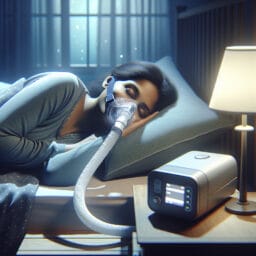
Exploring Holistic Approaches to Managing Sleep Apnea
Table of Contents
- Introduction
- Understanding Sleep Apnea
- Traditional Treatment Methods
- Holistic Approaches to Managing Sleep Apnea
- Case Studies
- Conclusion
- Frequently Asked Questions
Introduction
When exploring holistic approaches to treating sleep apnea, one must understand that obstructive sleep apnea is a common but serious sleep disorder. It manifests when the throat muscles intermittently relax during sleep, causing short periods where individuals stop breathing. This condition not only disrupts the quality of sleep but also poses an increased risk of various health issues if left untreated. Alternative medicine suggests several strategies to improve the quality of sleep and reduce sleep apnea symptoms without relying solely on conventional treatments like a CPAP machine. For instance, maintaining a healthy weight can significantly lower the risk of developing obstructive sleep apnea as obesity is known to worsen its symptoms. Equally important are modifications in sleeping habits and positions; side sleeping is particularly recommended for people with this condition as it helps keep the upper airway open for easier respiratory function. Regular practice of certain breathing exercises can also help strengthen the respiratory system over time, further helping to manage this disorder effectively. Additionally, essential oils such as eucalyptus oil have shown potential in opening up airways and improving nighttime breathing patterns when used properly under guidance from a healthcare provider.
Understanding Sleep Apnea
Striking a balance between maintaining an optimal body weight and adopting healthy sleeping habits can contribute significantly to managing obstructive sleep apnea. Known as one of the main types of this prevalent sleep disorder, obstructive sleep apnea often leads to short periods where individuals stop breathing due to the intermittent relaxation of throat muscles during slumber. Research indicates that those carrying excessive weight are at higher risk for developing sleep apnea, particularly due to the fact that obesity can worsen symptoms by exerting additional pressure on the upper airway.
However, it is not just about weight loss; focusing on improving your overall health increases your chances of reducing sleep apnea symptoms. Regular exercise is beneficial for both maintaining a healthy weight and strengthening your respiratory system – two critical elements in treating sleep apnea effectively without reliance on machines like a CPAP device. Incorporating routine breathing exercises into your daily regimen aids in keeping your airway open during sleep, minimizing interruptions caused by impaired breathing.
Of equal importance are modifications in sleeping position and habits. Although it might seem insignificant, studies suggest that side sleeping greatly benefits people with obstructive sleep apnea as it can help keep their upper airways open for improved quality of rest compared to other positions such as back or stomach sleeping. Additionally, becoming mindful of our lifestyle choices – limiting alcohol consumption before bedtime and quitting smoking – may also lead to substantial improvements.
Essential oils have found their way into alternative medicine strategies aimed at managing this disruptive condition too. When used under guidance from a health care provider, eucalyptus oil has shown promise in aiding nighttime breathing patterns by opening up airways more effectively than some traditional treatments.
Bringing these holistic approaches together presents an empowering home treatment strategy for those grappling with this challenging condition. These self-management techniques do more than just alleviate daytime sleepiness associated with poor-quality slumber; they provide much-needed relief from constant awakenings during the night owing to interrupted airflow – a hallmark of sleep apnea. No singular solution works for everyone, and it is critical to seek guidance from your health care provider in order to adopt the combination of strategies that best suits you.
While conventional diagnostic procedures such as sleep studies are essential for confirming sleep apnea types and their severity, integrating these holistic approaches can significantly improve the quality of life for those living with this condition, reducing reliance on intrusive oral appliances or machines. Remember, early detection increases treatment success rates but combining medical interventions with lifestyle alterations can offer long-term relief from this common yet serious disorder.
| Key Points | Impact |
|---|---|
| Maintaining optimal body weight | Helps in managing obstructive sleep apnea by reducing pressure on the upper airway |
| Healthy sleeping habits | Improves the quality of rest and minimizes intermittent relaxation of throat muscles during slumber |
| Regular exercise and breathing exercises | Strengthens the respiratory system and keeps airway open during sleep, reducing reliance on machines like CPAP device |
| Modifications in sleeping position | Side sleeping can help keep upper airways open, benefiting individuals with obstructive sleep apnea |
| Lifestyle choices | Limiting alcohol consumption before bedtime and quitting smoking may lead to substantial improvements in sleep apnea symptoms |
| Use of essential oils (e.g. eucalyptus oil) | Can aid nighttime breathing patterns by opening up airways, providing an alternative medicine strategy |
| Conventional diagnostic procedures | Essential for confirming sleep apnea types and their severity, but can be complemented by holistic approaches for improved quality of life |
Traditional Treatment Methods
While Continuous Positive Airway Pressure (CPAP) machines are often the go-to treatment option for obstructive sleep apnea, they require the wearer to sleep with a mask and can cause discomfort and inconvenience. These devices work by forcing air through the upper airway to prevent collapse and reduce sleep interruptions. However, holistic practices suggest alternative treatments that don’t rely on such machinery to manage this common sleep disorder.
For some people struggling with bedtime breathlessness or daytime sleepiness due to interrupted airflow, an oral appliance could be a beneficial intervention. Dentists custom-fit these devices which reposition the lower jaw or tongue during sleep, keeping the airway open. They’re less intrusive than CPAP machines but require regular adjustments and may not be as effective in severe cases of obstructive sleep apnea.
On another note, surgical options exist for those who have exhausted other remedies without significant improvement in their symptoms. Procedures range from tissue removal in throat area to nerve stimulators that control breathing muscles directly; yet each carries its unique risks including complications post-operation or ineffectiveness over time. It’s crucial that patients discuss these potential outcomes with their health care provider before choosing this route.
That being said, it’s important not to overlook lifestyle changes when treating sleep apnea holistically. Achieving weight loss can significantly reduce symptoms for many people given obesity’s propensity increase risk; moreover maintaining a healthy weight overall can lower one’s chances of developing obstructive sleep apnea altogether.
Another easily incorporated practice involves modifications of sleeping habits – particularly adopting side sleeping position which is known alleviate disturbances caused by impaired respiration during slumber as it helps keep upper airways unblocked more effectively than typical supine posture adopted by back-sleepers.
In addition, essential oils such as eucalyptus oil offer an appealing approach within arena of alternative medicine – when used under guidance from healthcare provider they’ve shown promise in aiding nocturnal breathing patterns opening up airways more effectively than some traditional treatments.
Lastly, incorporating routine breathing exercises can strengthen the respiratory system and help keep your airway open during sleep, minimizing interruptions caused by this prevalent condition. By integrating these various strategies alongside conventional sleep apnea treatment methods, one could significantly improve their quality of sleep and overall health without solely relying on CPAP machines or surgical interventions.
Holistic Approaches to Managing Sleep Apnea
Fascinatingly, the management of obstructive sleep apnea extends beyond the traditional bounds of medical treatments such as CPAP machines, and delves into a realm where lifestyle modifications play a pivotal role. Weight loss is often championed in this arena, serving as a potent weapon against this common sleep disorder. A healthy weight not only mitigates the symptoms of sleep apnea but also reduces one’s chances of developing it. Regular exercise goes hand-in-hand with weight loss efforts, acting as another pillar in treating sleep apnea holistically. Together, they help alleviate daytime sleepiness and other ailments attributed to poor quality rest.
In addition to maintaining an optimal weight and regular physical activity, dietary choices significantly impact the severity of obstructive sleep apnea symptoms. Consuming balanced meals rather than opting for quick fixes laden with unhealthy fats or sugars can have noticeable effects on your overall health and ability to manage this condition effectively.
Moving onto another tool within our natural arsenal – breathing exercises – we find a method rooted deeply in alternative medicine practices aimed at strengthening the respiratory system over time. These exercises are designed to keep your upper airway open during slumber by training your throat muscles steadily; reducing short periods where individuals stop breathing which commonly disrupts their peaceful slumber.
Delving deeper into positional therapy reveals how simple changes like shifting one’s sleeping position can dramatically improve quality of sleep for those living with obstructive sleep apnea. Side sleeping is particularly beneficial for individuals dealing with this condition as it promotes an open airway throughout the night; providing much-needed relief from recurrent awakenings due to interrupted airflow – which is prevalent among back or stomach-sleepers.
Lastly, herbal remedies provide yet another holistic avenue worth exploring when seeking relief from bothersome symptoms associated with this common disorder. Essential oils such as eucalyptus oil have gained traction within alternative medicine circles due to their potential efficacy in opening up airways during restful hours; leading to better nighttime breathing patterns and improved sleep quality.
In essence, the holistic approach to managing sleep apnea targets not only the physical manifestations but also seeks to make positive adjustments in one’s lifestyle habits. It is a balanced blend of dietary improvements, weight management, regular exercise as well as incorporating mindful practices such as routine breathing exercises and positional therapy. Furthermore, exploring natural remedies like essential oils adds an extra layer of potential relief from this disruptive condition. In consultation with your health care provider, these home treatments can serve as invaluable companions to traditional sleep apnea treatment methods; offering significant improvements in overall health and quality of life whilst reducing reliance on more intrusive interventions.
| Holistic Approaches | Description | Benefits |
|---|---|---|
| Weight Loss | Regular diet and exercise to maintain a healthy weight. | Reduces the symptoms and development of sleep apnea. |
| Regular Exercise | Engaging in physical activities regularly. | Helps alleviate daytime sleepiness and other ailments attributed to poor quality rest. |
| Dietary Choices | Making healthy choices in diet by consuming balanced meals. | Reduces the severity of obstructive sleep apnea symptoms. |
| Breathing Exercises | Practicing regular breathing exercises to strengthen respiratory system. | Helps keep upper airway open during slumber. |
| Positional Therapy | Changing sleeping position, preferably side sleeping. | Improves quality of sleep by maintaining an open airway throughout the night. |
| Herbal Remedies | Use of herbal remedies such as essential oils like eucalyptus oil. | Opens up airways during restful hours leading to better nighttime breathing patterns and improved sleep quality. |
Case Studies
It’s intriguing to note that countless individuals have found solace in managing their obstructive sleep apnea symptoms through holistic approaches. In fact, many people marked by a higher risk of developing sleep apnea due to factors such as obesity have achieved notable improvements in their quality of slumber through targeted weight loss and regular exercise. Maintaining a healthy weight not only helps them reduce symptoms and stop the nocturnal breathing interruptions but also acts as a preventative measure against this prevalent sleep disorder. Similarly, adopting altered sleeping habits has been instrumental for several side sleepers who managed to keep their upper airway open during rest, mitigating frequent awakenings caused by blocked airflow commonly faced by back or stomach-sleepers.
In tandem with these lifestyle changes, the use of essential oils like eucalyptus oil under guided supervision from healthcare providers has shown promising results in bettering nighttime breathing patterns. This path of alternative medicine coupled with routine practice of certain breathing exercises designed to strengthen the respiratory system has proved fruitful for several individuals combating this common disorder.
The takeaway is that while conventional methods like CPAP machines and oral appliances play an indispensable role in treating sleep apnea, integrating holistic strategies can offer long-term relief and substantially improve day-to-day living for those grappling with this condition. It’s all about finding the right blend of medical treatments alongside home remedies tailored specifically to one’s needs under expert guidance.
Conclusion
For those grappling with sleep apnea, a common sleep disorder marked by intermittent cessation in breathing due to relaxed throat muscles, holistic approaches can offer significant improvements in managing symptoms and enhancing sleep quality. These methods include weight loss for obesity-related cases, positional adjustments like side sleeping which helps keep the upper airway open, and routinely practicing breathing exercises to strengthen the respiratory system. Essential oils such as eucalyptus oil have also shown potential under guided supervision to aid nighttime breathing patterns. While traditional methods like CPAP machines or oral appliances are key in treating this condition, integrating these strategies can significantly reduce sleep interruptions and daytime sleepiness associated with obstructive sleep apnea. It’s important for anyone experiencing increased risk or worsening symptoms to consult their health care provider about both conventional treatments and alternative medicine options that could potentially provide long-term relief.



